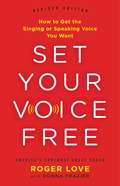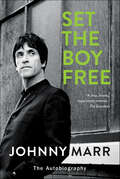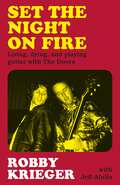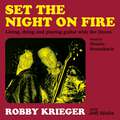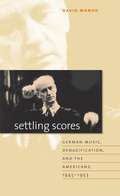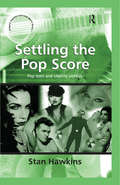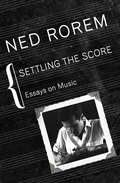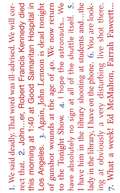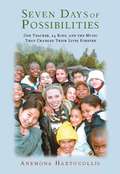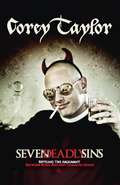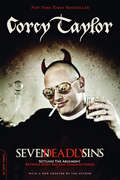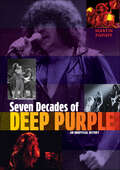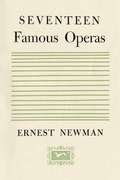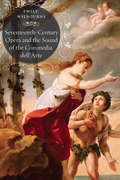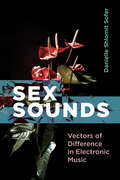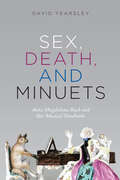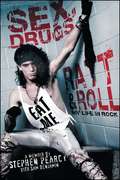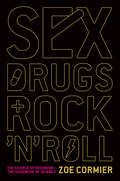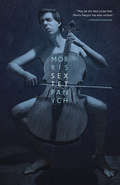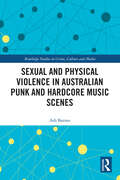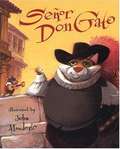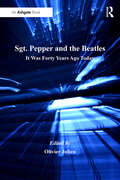- Table View
- List View
Set Your Voice Free: How to Get the Singing or Speaking Voice You Want
by Roger Love Donna FrazierThe greatest vocal coach in the world will help you get the voice you want. Every time we open our mouths, we have an effect on ourselves and the way others perceive us. The ability to speak clearly and confidently can make or break a presentation, an important meeting, or even a first date. Now, with the advent of Skype, YouTube, podcasting, Vine, and any number of reality talent competitions, your vocal presence has never been more necessary for success or more central to achieving your dreams.Roger Love has over 30 years of experience as one of the world's leading authorities on voice. Making use of the innovative techniques that have worked wonders with his professional clients, Love distills the best of his teaching in SET YOUR VOICE FREE, and shares exercises that will help readers bring emotion, range, and power to the way they speak.This updated edition incorporates what he's learned in the last 15 years as the Internet and talent competitions have completely changed the role your voice plays in your life. These are the new essentials for sounding authentic, persuasive, distinctive, and real in a world that demands nothing less.
Set the Boy Free: The Autobiography
by Johnny MarrThe long-awaited memoir from the legendary guitarist and cofounder of the seminal British band The Smiths.An artist who helped define a period in popular culture, Johnny Marr tells his story in a memoir as vivid and arresting as his music. The Smiths, the band with the signature sound he cofounded, remains one of the most beloved bands ever, and have a profound influence on a number of acts that followed—from the Stone Roses, Suede, Blur, and Radiohead to Oasis, The Libertines, and Arctic Monkeys.Marr recalls his childhood growing up in the northern working-class city of Manchester, in a house filled with music. He takes us back to the summer of 1982 when, at eighteen, he sought out one Stephen Morrissey to form a new band they called The Smiths. Marr invites fans on stage, on the road, and in the studio for the five years The Smiths were together and how after a rapid ascent, the working-class teenage rock star enjoyed and battled with the perks of success until ideological differences, combined with his much publicized strained relationships with fellow band mates, caused him to leave in 1987. Marr’s “escape” as he calls it, ensured the beginning of the end for one of the most influential groups of a generation. But The Smiths’ end was only the beginning for Marr. The bona-fide guitar hero continues to experiment and evolve in his solo career to this day, playing with Paul McCartney, Pretenders, Modest Mouse, Oasis and collaborating today’s most creative and renowned artists. Rising above and beyond the personal struggles and bitter feuds, Marr delivers the story of his music and his band, sharing the real insights of a man who has made music his life, and finally giving fans what they’ve truly been waiting for.
Set the Night on Fire: Living, Dying and Playing Guitar with the Doors
by Robby KriegerFew bands are as shrouded in the murky haze of rock mythology as The Doors, and parsing fact from fiction has been a virtually impossible task. But now, after fifty years, The Doors' notoriously quiet guitarist is finally breaking his silence to set the record straight.Through a series of vignettes, Robby takes readers back to where it all happened: the pawn shop where he bought his first guitar; the jail cell he was tossed into after a teenage drug bust; his parents' living room where his first songwriting sessions with Jim Morrison took place; and the many concert venues that erupted into historic riots.Robby also goes into heartbreaking detail about his life's most difficult struggles, ranging from drug addiction to cancer, but he balances out the sorrow with humorous anecdotes about run-ins with unstable fans, famous musicians, and one really angry monk. SET THE NIGHT ON FIRE is at once an insightful time capsule of 1960s counterculture and a moving reflection on what it means to find oneself as a musician. It's not only a must-read for Doors fans, but an essential volume of American pop culture history.
Set the Night on Fire: Living, Dying and Playing Guitar with the Doors
by Robby KriegerFew bands are as shrouded in the murky haze of rock mythology as The Doors, and parsing fact from fiction has been a virtually impossible task. But now, after fifty years, The Doors' notoriously quiet guitarist is finally breaking his silence to set the record straight.Through a series of vignettes, Robby takes readers back to where it all happened: the pawn shop where he bought his first guitar; the jail cell he was tossed into after a teenage drug bust; his parents' living room where his first songwriting sessions with Jim Morrison took place; and the many concert venues that erupted into historic riots.Robby also goes into heartbreaking detail about his life's most difficult struggles, ranging from drug addiction to cancer, but he balances out the sorrow with humorous anecdotes about run-ins with unstable fans, famous musicians, and one really angry monk. SET THE NIGHT ON FIRE is at once an insightful time capsule of 1960s counterculture and a moving reflection on what it means to find oneself as a musician. It's not only a must-read for Doors fans, but an essential volume of American pop culture history.
Set the Night on Fire: Living, Dying, and Playing Guitar With the Doors
by Robby KriegerOne of AARP&’s Nine New Music Memoirs and Biographies for Rock and Blues FansIn his tell-all, legendary Doors guitarist, Robby Krieger, one of Rolling Stone&’s &“100 Greatest Guitarists of All Time,&” opens up about his band&’s meteoric career, his own darkest moments, and the most famous black eye in rock &‘n&’ roll. Few bands are as shrouded in the murky haze of rock mythology as The Doors, and parsing fact from fiction has been a virtually impossible task. But now, after fifty years, The Doors&’ notoriously quiet guitarist is finally breaking his silence to set the record straight.Through a series of vignettes, Robby Krieger takes readers back to where it all happened: the pawn shop where he bought his first guitar; the jail cell he was tossed into after a teenage drug bust; his parents&’ living room where his first songwriting sessions with Jim Morrison took place; the empty bars and backyard parties where The Doors played their first awkward gigs; the studios where their iconic songs were recorded; and the many concert venues that erupted into historic riots. SET THE NIGHT ON FIRE is packed with never-before-told stories from The Doors&’ most vital years, and offers a fresh perspective on the most infamous moments of the band&’s career.Krieger also goes into heartbreaking detail about his life&’s most difficult struggles, ranging from drug addiction to cancer, but he balances out the sorrow with humorous anecdotes about run-ins with unstable fans, famous musicians, and one really angry monk. SET THE NIGHT ON FIRE is at once an insightful time capsule of the &‘60s counterculture, a moving reflection on what it means to find oneself as a musician, and a touching tale of a life lived non-traditionally. It&’s not only a must-read for Doors fans, but an essential volume of American pop culture history.
Settin' the Woods on Fire: Confessions of Hank’s Steel Guitar Player
by Donald Hugh Helms Dale M. VinicurBiography of one of Hank Williams' fellow musicians, Don Helms
Setting the Tone: Essays and a Diary
by Ned RoremA sterling collection of essays, commentary, reviews, and personal recollections on art, love, and the musical life, from Ned Rorem, award-winning composer and author extraordinaireNed Rorem, the acclaimed American composer and writer, displays his incisive, sometimes outrageous genius for artistic critique and social commentary with a grand flourish in this engaging collection of essays and diary entries. Fearlessly offering opinions on a wealth of subjects—from the lives of the famous and infamous to popular culture to the state of contemporary art—Rorem proves once again that he is an artist who tells unforgettable stories not only through music, but with a pen, as well. Setting the Tone gathers together essays and commentary previously published elsewhere and combines them with pages from Rorem&’s ongoing diary, offering readers a vivid and enlightening view of Rorem&’s world along with an honest portrait of the author himself. Whether he&’s lambasting critics and former friends and acquaintances, vivisecting opera, or presenting his views on theater, film, books, or composers and their music, Rorem is ingenious, incorrigible, and madly entertaining.
Settling Scores
by David MonodClassical music was central to German national identity in the early twentieth century. The preeminence of composers such as Bach and Beethoven and artists such as conductor Wilhelm Furtwangler and pianist Walter Gieseking was cited by the Nazis as justification for German expansionism and as evidence of Aryan superiority. In the minds of many Americans, further German aggression could be prevented only if the population's faith in its moral and cultural superiority was shattered. In Settling Scores, David Monod examines the attempted "denazification" of the German music world by the Music Control Branch of the Information Control Division of Military Government. The occupying American forces barred from the stage and concert hall all former Nazi Party members and even anyone deemed to display an "authoritarian personality." They also imported European and American music. These actions, however, divided American officials and outraged German audiences and performers. Nonetheless, the long-term effects were greater than has been previously recognized, as German government officials regained local control and voluntarily limited their involvement in artistic life while promoting "new" (anti-Nazi) music.
Settling the Pop Score: Pop Texts and Identity Politics (Ashgate Popular And Folk Music Ser.)
by Stan HawkinsThe analysis of popular music forces us to rethink the assumptions that underpin our approaches to the study of Western music. Not least, it brings to the fore an idea that many musicologists still find uncomfortable - that commercial production and consumption can be aligned with artistic authenticity. Reading pop texts takes place through dialogue on many levels, which, as Stan Hawkins argues, deals with how musical events are shaped by personal alliances between the artist and the recipient. The need for a critical approach to evaluating popular music lies at the heart of this book. Hawkins explores the relationships that exist between music, spectatorship and aesthetics through a series of case studies of pop artists from the 1980s and 1990s. Madonna, Morrissey, Annie Lennox, the Pet Shop Boys and Prince represent the diversity of cultures, identities and sexualities that characterised the start of the MTV boom. Through the interpretation of aspects of the compositional design and musical structures of songs by these pop artists, Hawkins suggests ways in which stylistic and technical elements of the music relate to identity formation and its political motivations. Settling the Pop Score examines the role of irony and empathy, the question of gender, race and sexuality, and the relevance of textual analysis to the study of popular music. Interpreting pop music within the framework of musicology, Hawkins helps us to understand the pleasure so many people derive from these songs.
Settling the Score: Essays on Music
by Ned RoremNed Rorem explores the state of contemporary classical music in a magnificent collection of personally selected essays and critiques of masterworks, lesser works, and their legendary creatorsPulitzer Prize–winner Ned Rorem&’s musical compositions are considered some of the finest produced in the past century. His literary works have been hailed as &“scintillating&” (Time magazine) and &“extraordinary&” (The Washington Post). Rorem&’s remarkable twin talents are brilliantly intertwined in Settling the Score, a masterful collection of essays on music, composers, and the state of the art. Selected by Rorem himself, these enthralling and provocative pieces examine the works of the great and (in the author&’s lively, unabashed opinion) the not-so-great masters of twentieth-century classical music—Debussy, Ravel, Copland, Gershwin, Barber, Cage, Bernstein, Britten, Stravinsky, and others. With keen precision, he dissects the so-called serious music of our time while predicting where the form is bound in the future. Never lacking in intelligence or wit, each essay in Settling the Score sings in a voice that is clear and true.
Seven American Deaths and Disasters
by Kenneth GoldsmithIn Seven American Deaths and Disasters, Kenneth Goldsmith transcribes words used by people describing events they had never prepared themselves to witness, as they unfurl. In doing so, he reveals an extraordinarily rich linguistic panorama of passionate description. Taking its name from the Warhol paintings of the same name, Goldsmith recasts the mundane as the iconic, creating a sense of prose poems that encapsulate both the Kennedy assassinations, that of John Lennon, the Space Shuttle Challenger disaster, 9/11 and the death of Michael Jackson.
Seven Days Of Possibilities: One Teacher, 24 Kids, and the Music That Changed Their Lives Forever
by Anemona HartocollisThe inspirational true story of one plucky young teacher, whose passion for her students transformed their livesusome for only seven days, others for a lifetime"
Seven Deadly Sins: Settling the Argument Between Born Bad and Damaged Good
by Corey TaylorFor the first time, Slipknot and Stone Sour frontman Corey Taylor speaks directly to his fans and shares his worldview about life as a sinner. And Taylor knows how to sin. As a small-town hero in the early '90s, he threw himself into a fierce-drinking, drug-abusing, hard-loving, live-for-the moment life. Soon Taylor's music exploded, and he found himself rich, wanted, and on the road. His new and ever-more extreme lifestyle had an unexpected effect, however; for the first time, he began to actively think about what it meant to sin and whether sinning could--or should--be recast in a different light. Seven Deadly Sins is Taylor's personal story, but it's also a larger discussion of what it means to be seen as either a "good" person or a "bad" one. Yes, Corey Taylor has broken the law and hurt people, but, if sin is what makes us human, how wrong can it be?
Seven Deadly Sins: Settling the Argument Between Born Bad and Damaged Good
by Corey TaylorFor the first time, Slipknot and Stone Sour frontman Corey Taylor speaks directly to his fans and shares his worldview about life as a sinner. And Taylor knows how to sin. As a small-town hero in the early ’90s, he threw himself into a hard-drinking, fierce-loving, live-for-the-moment life; when his music exploded, he found himself rich, wanted, and on the road. But soon his extreme lifestyle led him to question what it means to sin and whether it could—or should—be cast in a different light. After all, if sin makes us human how wrong can it be?Now updated with a new Afterword by the author, Seven Deadly Sins is a brutally honest look “at a life that could have gone horribly wrong at any turn,” and the soul-searching and self-discovery it took to set it right.
Seven Decades of Deep Purple: An Unofficial History
by Martin PopoffSeven Decades of Deep Purple tells the electrifying story of one of the most iconic bands in rock history. From the band&’s explosive formation in 1968 to the classic Mk. II lineup—Gillan, Blackmore, Glover, Lord, and Paice—and through all the iterations to the present day, this book delves deep into the band that brought the world unforgettable hits like &“Hush,&” &“Speed King,&” &“Smoke on the Water,&” &“Highway Star,&” and &“Perfect Strangers.&” Through nearly 50 interviews by the author with Purple alumni, plus dozens more with others who are part of this story, readers will journey through the group&’s formation, lineup changes, album sessions, and live performances. Album by album, it&’s Deep Purple&’s music that gives this book its solid-rock foundation. Starting with 1968&’s Shades of Deep Purple, the book discusses all their genre-defining albums, including In Rock, Fireball, Machine Head, Burn, Purpendicular, and 2024&’s =1. Whether you&’re a lifelong fan or new to their music, this book is a must-read for anyone wanting to explore the legacy of one of rock&’s most enduring and relentlessly vital and creative forces.
Seventeen Famous Operas
by Ernest Newman“The great composer does not set to work because he is inspired, but becomes inspired because he is working.” –Ernest Newman In Seventeen Famous Operas, renowned musicologist and music critic Ernest Newman goes beyond simply retelling the plots of the operas he has chosen to feature in this volume. Because for Newman, opera was theater—and he demonstrates that with his in-depth studies of the seventeen featured operas. Newman uses biographical, literary, and historical background to expose the reader to how each featured work came to be. These featured works include La Boheme, Madame Butterfly, Carmen, La Traviata, The Marriage of Figaro, The Barber of Seville, The Magic Flute and ten other famous works. Seventeen Famous Operas is a must-read for music librarians, opera lovers, and propagandists of music everywhere.
Seventeenth-Century Opera and the Sound of the Commedia dell’Arte
by Emily WilbourneIn this book, Emily Wilbourne boldly traces the roots of early opera back to the sounds of the commedia dell’arte. Along the way, she forges a new history of Italian opera, from the court pieces of the early seventeenth century to the public stages of Venice more than fifty years later. Wilbourne considers a series of case studies structured around the most important and widely explored operas of the period: Monteverdi’s lost L’Arianna, as well as his Il Ritorno d’Ulisse and L’incoronazione di Poppea; Mazzochi and Marazzoli’s L’Egisto, ovvero Chi soffre speri; and Cavalli’s L’Ormindo and L’Artemisia. As she demonstrates, the sound-in-performance aspect of commedia dell’arte theater—specifically, the use of dialect and verbal play—produced an audience that was accustomed to listening to sonic content rather than simply the literal meaning of spoken words. This, Wilbourne suggests, shaped the musical vocabularies of early opera and facilitated a musicalization of Italian theater. Highlighting productive ties between the two worlds, from the audiences and venues to the actors and singers, this work brilliantly shows how the sound of commedia performance ultimately underwrote the success of opera as a genre.
Sex Sounds: Vectors of Difference in Electronic Music
by Danielle Shlomit SoferAn investigation of sexual themes in electronic music since the 1950s, with detailed case studies of &“electrosexual music&” by a wide range of creators. In Sex Sounds, Danielle Shlomit Sofer investigates the repeated focus on sexual themes in electronic music since the 1950s. Debunking electronic music&’s origin myth—that it emerged in France and Germany, invented by Pierre Schaeffer and Karlheinz Stockhausen, respectively—Sofer defines electronic music more inclusively to mean any music with an electronic component, drawing connections between academic institutions, radio studios, experimental music practice, hip-hop production, and histories of independent and commercial popular music. Through a broad array of detailed case studies—examining music that ranges from Schaeffer&’s musique concrète to a video workshop by Annie Sprinkle—Sofer offers a groundbreaking look at the social and cultural impact sex has had on audible creative practices. Sofer argues that &“electrosexual music&” has two central characteristics: the feminized voice and the &“climax mechanism.&” Sofer traces the historical fascination with electrified sex sounds, showing that works representing women&’s presumed sexual experience operate according to masculinist heterosexual tropes, and presenting examples that typify the electroacoustic sexual canon. Noting electronic music history&’s exclusion of works created by women, people of color, women of color, and, in particular Black artists, Sofer then analyzes musical examples that depart from and disrupt the electroacoustic norms, showing how even those that resist the norms sometimes reinforce them. These examples are drawn from categories of music that developed in parallel with conventional electroacoustic music, separated—segregated—from it. Sofer demonstrates that electrosexual music is far more representative than the typically presented electroacoustic canon.
Sex, Death, and Minuets: Anna Magdalena Bach and Her Musical Notebooks (New Material Histories of Music)
by David YearsleyAt one time a star in her own right as a singer, Anna Magdalena (1701–60) would go on to become, through her marriage to the older Johann Sebastian Bach, history’s most famous musical wife and mother. The two musical notebooks belonging to her continue to live on, beloved by millions of pianists young and old. Yet the pedagogical utility of this music—long associated with the sound of children practicing and mothers listening—has encouraged a rosy and one-sided view of Anna Magdalena as a model of German feminine domesticity. Sex, Death, and Minuets offers the first in-depth study of these notebooks and their owner, reanimating Anna Magdalena as a multifaceted historical subject—at once pious and bawdy, spirited and tragic. In these pages, we follow Magdalena from young and flamboyant performer to bereft and impoverished widow—and visit along the way the coffee house, the raucous wedding feast, and the family home. David Yearsley explores the notebooks’ more idiosyncratic entries—like its charming ditties on illicit love and searching ruminations on mortality—against the backdrop of the social practices and concerns that women shared in eighteenth-century Lutheran Germany, from status in marriage and widowhood, to fulfilling professional and domestic roles, money, fashion, intimacy and sex, and the ever-present sickness and death of children and spouses. What emerges is a humane portrait of a musician who embraced the sensuality of song and the uplift of the keyboard, a sometimes ribald wife and oft-bereaved mother who used her cherished musical notebooks for piety and play, humor and devotion—for living and for dying.
Sex, Drugs, Ratt & Roll
by Sam Benjamin Stephen PearcyA jaw-dropping tell-all from the lead singer of the 1980s supergroup Ratt: the groupies, the trashed hotel rooms, the drugs--and just how much you can get away with when you're one of the biggest hair metal stars of all time.In the mid-1980s, Ratt, alongside Motley Crüe, Poison, and Quiet Riot, were laying down the riffs and unleashing the scissor kicks that would herald the arrival of music's most flamboyantly debauched era. Now with Sex, Drugs, Ratt & Roll, Ratt frontman and chief rabble-rouser Stephen Pearcy divulges all the dirty details of the era when big-haired bands ruled the world. Stephen was primed for a life of excess from an early age--his father died of a heroin overdose when he was twelve, and by the age of fifteen, Stephen was himself a drug addict. When Stephen met the thrill-seeking Robbin Crosby, he knew he'd found his perfect partner in crime--both in music and partying. Ratt's 1984 debut single, "Round and Round," became one of the top-selling metal songs of all time, but it was the band's off-stage escapades that were the stuff of legend. "Our tour bus is like our pirate ship, it's where we rape and pillage," said Pearcy in 1987. Now Pearcy's memoir reveals all the rock star excess--the partying, the women, the $2,000-a-day drug habits--letting fans see into this harrowing hair-metal lifestyle and what it's really like behind the scenes when you're a rock star.
Sex, Drugs, and Rock 'n' Roll: The Science of Hedonism and the Hedonism of Science
by Zoe CormierFull of noise and color, Sex, Drugs, and Rock ’n’ Roll looks at scientists and their craft, how hedonistic impulses inform our highest pursuits, and how the renegades of science have illuminated the secrets of our deepest impulses. It is a fascinating tale of scientists on the edge, experimenting on themselves and others, that asks the big (and strange) questions about what it means to be human, about consciousness and happiness, the future and past of our species, our scientific knowledge, and our culture. Not to mention our parties. It will pull you in and gross you out, but it never loses sight of the stories, ideas, and scientific discoveries that make sex, drugs, and rock ’n’ roll so timeless.
Sextet
by Morris Panych"The best script Morris Panych has ever written."?Toronto StarA blizzard strands six musicians in their motel with only their instruments, each other, and their secrets to keep them warm. Where will everyone sleep when everyone is sleeping with everyone else? Morris Panych is internationally recognized as one of North America's master playwrights.
Sexual and Physical Violence in Australian Punk and Hardcore Music Scenes (Routledge Studies in Crime, Culture and Media)
by Ash BarnesFocused on the Australian punk and hardcore music scene, this book provides an innovative balance between the acknowledgement of harm and the celebration of pleasure in live music spaces.Despite decades of advocacy within vibrant music communities, stories of sexual and physical violence persist. Although anecdotally common in alternative music cultures, the interpretation and experiences of harm have remained absent from criminological analysis. Gradients of harm dictate and frame certain behaviour as ‘unacceptable’ or ‘encouraged’ under specific social conditions. As explored through qualitative research interviews and the author’s lived experience, violence within music scenes is a complex, personal, and collective experience.Issues such as discrimination, social inequality, stereotyping and rape myth acceptance are instrumental in shaping how people in the punk and hardcore scenes fail to recognise, minimize, and dismiss violence in their community. This text questions how and why some people are ‘worthy’ or ‘unworthy’ victims of crime, and why harmful behaviour continues within these spaces.Sexual and Physical Violence in Australian Punk and Hardcore Music Scenes will be of interest to researchers in the field of criminology and sociology but is also applicable to a wider academic audience interested in violence, deviance, and subcultures.
Señor Don Gato: A Traditional Song
by John MandersWhen he climbs on a roof to read a love letter, a cat has an unfortunate fall with unexpected consequences.
Sgt. Pepper and the Beatles: It Was Forty Years Ago Today (Ashgate Popular and Folk Music Series)
by Olivier JulienThe first concept album in the history of popular music, the soundtrack of the Summer of Love or 'Hippy Symphony No. 1': Sgt. Pepper's Lonely Hearts Club Band is first and foremost the album that gave rise to 'hopes of progress in pop music' (The Times, 29 May 1967). Sgt. Pepper and the Beatles commemorates the fortieth anniversary of this masterpiece of British psychedelia by addressing issues that will help put the record in perspective. These issues include: reception by rock critics and musicians, the cover, lyrics, songwriting, formal unity, the influence of non-European music and art music, connections with psychedelia and, more generally, the sociocultural context of the 1960s, production, sound engineering and musicological significance. The contributors are world renowned for their work on the Beatles: they examine Sgt. Pepper from the angle of disciplines such as musicology, ethnomusicology, history, sociology, literature, social psychology and cultural theory.
